Human Disturbance and Geometric Constraints Drive Small Mammal Diversity and Community Structure along an Elevational Gradient in Eastern China
Abstract
:Simple Summary
Abstract
1. Introduction
2. Materials and Methods
2.1. Study Area
2.2. Sampling
2.3. Species Trait Data
2.4. Phylogenetic Analyses
2.5. Diversity Indices
2.6. Functional and Phylogenetic Structure
2.7. Explanatory Variables
2.8. Data Analyses
3. Results
4. Discussion
4.1. Elevational Patterns of Small Mammal Diversity
4.2. Community Assembly Mechanisms
4.3. Drivers of Diversity Patterns
4.4. Conservation Implications
5. Conclusions
Supplementary Materials
Author Contributions
Funding
Institutional Review Board Statement
Data Availability Statement
Acknowledgments
Conflicts of Interest
References
- Rahbek, C.; Borregaard, M.K.; Colwell, R.K.; Dalsgaard, B.; Holt, B.G.; Morueta-Holme, N.; Nogues-Bravo, D.; Whittaker, R.J.; Fjeldså, J. Humboldt’s enigma: What causes global patterns of mountain biodiversity? Science 2019, 365, 1108–1113. [Google Scholar] [CrossRef] [PubMed]
- Sun, R.H.; Chen, L.D.; Zhang, B.P.; Fu, B.J. Vertical zonation of mountain landscape: A review. Chin. J. Appl. Ecol. 2009, 20, 1617–1624. [Google Scholar]
- Sanders, N.J.; Rahbek, C. The patterns and causes of elevational diversity gradients. Ecography 2012, 35, 1–3. [Google Scholar] [CrossRef]
- Chen, Z.Z.; He, K.; Cheng, F.; Khanal, L.; Jiang, X.L. Patterns and underlying mechanisms of non-volant small mammal richness along two contrasting mountain slopes in southwestern China. Sci. Rep. 2017, 7, 13277. [Google Scholar] [CrossRef] [Green Version]
- McCain, C.M.; Grytnes, J.-A. Elevational gradients in species richness. In Encyclopedia of Life Sciences; John Wiley & Sons, Ltd.: Chichester, UK, 2010; p. a0022548. [Google Scholar] [CrossRef]
- Perrigo, A.; Hoorn, C.; Antonelli, A. Why mountains matter for biodiversity. J. Biogeogr. 2020, 47, 315–325. [Google Scholar] [CrossRef] [Green Version]
- Gebrehiwot, K.; Demissew, S.; Woldu, Z.; Fekadu, M.; Desalegn, T.; Teferi, E. Elevational changes in vascular plants richness, diversity, and distribution pattern in Abune Yosef mountain range, Northern Ethiopia. Plant Divers. 2019, 41, 220–228. [Google Scholar] [CrossRef]
- Kamenistak, J.; Balaz, I.; Tulis, F.; Jakab, I.; Sevcik, M.; Polacikova, Z.; Klimant, P.; Ambros, M.; Rychlik, L. Changes of small mammal communities with the altitude gradient. Biologia 2020, 75, 713–722. [Google Scholar] [CrossRef]
- Pan, X.Y.; Ding, Z.F.; Hu, Y.M.; Liang, J.C.; Wu, Y.J.; Si, X.F.; Guo, M.F.; Hu, H.J.; Jin, K. Elevational pattern of bird species richness and its causes along a central Himalaya gradient, China. PeerJ 2016, 4, e2636. [Google Scholar] [CrossRef] [Green Version]
- Pan, X.Y.; Liang, D.; Zeng, W.; Hu, Y.M.; Liang, J.C.; Wang, X.W.; Robinson, S.K.; Luo, X.; Liu, Y. Climate, human disturbance and geometric constraints drive the elevational richness pattern of birds in a biodiversity hotspot in southwest China. Glob. Ecol. Conserv. 2019, 18, e00630. [Google Scholar] [CrossRef]
- Sun, Y.X.; Liu, S.L.; Liu, Y.X.; Dong, Y.H.; Li, M.Q.; An, Y.; Shi, F.N.; Beazley, R. Effects of the interaction among climate, terrain and human activities on biodiversity on the Qinghai-Tibet Plateau. Sci. Total Environ. 2021, 794, 148497. [Google Scholar] [CrossRef]
- McCain, C.M.; King, S.R.B.; Szewczyk, T.; Beck, J. Small mammal species richness is directly linked to regional productivity, but decoupled from food resources, abundance, or habitat complexity. J. Biogeogr. 2018, 45, 2533–2545. [Google Scholar] [CrossRef]
- Pontarp, M.; Wiens, J.J. The origin of species richness patterns along environmental gradients: Uniting explanations based on time, diversification rate and carrying capacity. J. Biogeogr. 2017, 44, 722–735. [Google Scholar] [CrossRef] [Green Version]
- Colwell, R.K.; Rahbek, C.; Gotelli, N.J. The mid-domain effect and species richness patterns: What have we learned so far? Am. Nat. 2004, 163, E1–E23. [Google Scholar] [CrossRef] [Green Version]
- Srivastava, D.S.; Lawton, J.H. Why more productive sites have more species: An experimental test of theory using tree-hole communities. Am. Nat. 1998, 152, 510–529. [Google Scholar] [CrossRef]
- Waide, R.B.; Willig, M.R.; Steiner, C.F.; Mittelbach, G.; Gough, L.; Dodson, S.I.; Juday, G.P.; Parmenter, R. The relationship between productivity and species richness. Annu. Rev. Ecol. Syst. 1999, 30, 257–300. [Google Scholar] [CrossRef] [Green Version]
- Gillman, L.N.; Wright, S.D. Species richness and evolutionary speed: The influence of temperature, water and area. J. Biogeogr. 2014, 41, 39–51. [Google Scholar] [CrossRef]
- Hawkins, B.A.; Field, R.; Cornell, H.V.; Currie, D.J.; Guégan, J.-F.; Kaufman, D.M.; Kerr, J.T.; Mittelbach, G.G.; Oberdorff, T.; O’Brien, E.M.; et al. Energy, water, and broad-scale geographic patterns of species richness. Ecology 2003, 84, 3105–3117. [Google Scholar] [CrossRef] [Green Version]
- McCain, C.M. Could temperature and water availability drive elevational species richness patterns? A global case study for bats. Glob. Ecol. Biogeogr. 2007, 16, 1–13. [Google Scholar] [CrossRef]
- Pausas, J.G.; Carreras, J. The effect of bedrock type, temperature and moisture on species richness of Pyrenean Scots pine (Pinus sylvestris L.) forests. Vegetatio 1995, 116, 85–92. [Google Scholar] [CrossRef]
- Mcintyre, S.; Martin, T.G. Biophysical and human influences on plant species richness in grasslands: Comparing variegated landscapes in subtropical and temperate regions. Austral Ecol. 2001, 26, 233–245. [Google Scholar] [CrossRef]
- Mecenero, S.; Altwegg, R.; Colville, J.F.; Beale, C.M. Roles of spatial scale and rarity on the relationship between butterfly species richness and human density in South Africa. PLoS ONE 2015, 10, e0124327. [Google Scholar] [CrossRef] [PubMed] [Green Version]
- Nogués-Bravo, D.; Araújo, M.B.; Romdal, T.; Rahbek, C. Scale effects and human impact on the elevational species richness gradients. Nature 2008, 453, 216–219. [Google Scholar] [CrossRef] [PubMed] [Green Version]
- Ding, Z.F.; Hu, H.J.; Cadotte, M.W.; Liang, J.C.; Hu, Y.M.; Si, X.F. Elevational patterns of bird functional and phylogenetic structure in the central himalaya. Ecography 2021, 44, 1403–1417. [Google Scholar] [CrossRef]
- Dreiss, L.M.; Burgio, K.R.; Cisneros, L.M.; Klingbeil, B.T.; Patterson, B.D.; Presley, S.J.; Willig, M.R. Taxonomic, functional, and phylogenetic dimensions of rodent biodiversity along an extensive tropical elevational gradient. Ecography 2015, 38, 876–888. [Google Scholar] [CrossRef]
- Cadotte, M.W.; Carboni, M.; Si, X.F.; Tatsumi, S. Do traits and phylogeny support congruent community diversity patterns and assembly inferences? J. Ecol. 2019, 107, 2065–2077. [Google Scholar] [CrossRef]
- Sun, J.; Wen, Z.X.; Feijó, A.; Cheng, J.L.; Wang, Y.Q.; Li, S.; Ge, D.Y.; Xia, L.; Yang, Q.S. Elevation patterns and critical environmental drivers of the taxonomic, functional, and phylogenetic diversity of small mammals in a karst mountain area. Ecol. Evol. 2020, 10, 10899–10911. [Google Scholar] [CrossRef]
- Shi, W.; Wang, Y.Q.; Xiang, W.S.; Li, X.K.; Cao, K.F. Environmental filtering and dispersal limitation jointly shaped the taxonomic and phylogenetic beta diversity of natural forests in southern China. Ecol. Evol. 2021, 11, 8783–8794. [Google Scholar] [CrossRef]
- Boyce, A.J.; Shakya, S.; Sheldon, F.H.; Moyle, R.G.; Martin, T.E. Biotic interactions are the dominant drivers of phylogenetic and functional structure in bird communities along a tropical elevational gradient. Auk 2019, 136, ukz054. [Google Scholar] [CrossRef]
- Le Bagousse-Pinguet, Y.; Soliveres, S.; Gross, N.; Torices, R.; Berdugo, M.; Maestre, F.T. Phylogenetic, functional, and taxonomic richness have both positive and negative effects on ecosystem multifunctionality. Proc. Natl. Acad. Sci. USA 2019, 116, 8419–8424. [Google Scholar] [CrossRef] [Green Version]
- Xu, J.S.; Chen, Y.; Zhang, L.X.; Chai, Y.F.; Wang, M.; Guo, Y.X.; Li, T.; Yue, M. Using phylogeny and functional traits for assessing community assembly along environmental gradients: A deterministic process driven by elevation. Ecol. Evol. 2017, 7, 5056–5069. [Google Scholar] [CrossRef] [Green Version]
- Barve, S.; Ramesh, V.; Dotterer, T.M.; Dove, C.J. Elevation and body size drive convergent variation in thermo-insulative feather structure of Himalayan birds. Ecography 2021, 44, 680–689. [Google Scholar] [CrossRef]
- Rocha, J.L.; Brito, J.C.; Nielsen, R.; Godinho, R. Convergent evolution of increased urine-concentrating ability in desert mammals. Mammal Rev. 2021, 51, 482–491. [Google Scholar] [CrossRef]
- García-Navas, V. Phylogenetic and functional diversity of African muroid rodents at different spatial scales. Org. Divers. Evol. 2019, 19, 637–650. [Google Scholar] [CrossRef]
- Zhang, H.; Wu, G.Y.; Wu, Y.Q.; Yao, J.F.; You, S.; Wang, C.C.; Cheng, F.; Chen, J.J.; Tang, M.X.; Li, C.L.; et al. A new species of the genus Crocidura from China based on molecular and morphological data (Eulipotyphla: Soricidae). Zool. Syst. 2019, 4, 279–293. [Google Scholar] [CrossRef]
- Hu, T.L.; Cheng, F.; Xu, Z.; Chen, Z.Z.; Yu, L.; Ban, Q.; Li, C.L.; Pan, T.; Zhang, B.W. Molecular and morphological evidence for a new species of the genus Typhlomys (Rodentia: Platacanthomyidae). Zool. Res. 2021, 42, 100. [Google Scholar] [CrossRef]
- Martin, S.A.; Alhajeri, B.H.; Steppan, S.J. Dietary adaptations in the teeth of murine rodents (Muridae): A test of biomechanical predictions. Biol. J. Linn. Soc. 2016, 119, 766–784. [Google Scholar] [CrossRef] [Green Version]
- Kohli, B.A.; Rowe, R.J. Beyond guilds: The promise of continuous traits for mammalian functional diversity. J. Mammal. 2019, 100, 285–298. [Google Scholar] [CrossRef]
- Blomberg, S.P.; Garland, T.; Ives, A.R. Testing for phylogenetic signal in comparative data: Behavioral traits are more reliable. Evolution 2003, 57, 717. [Google Scholar] [CrossRef]
- Kembel, S.W.; Cowan, P.D.; Helmus, M.R.; Cornwell, W.K.; Morlon, H.; Ackerly, D.D.; Blomberg, S.P.; Webb, C.O. Picante: R tools for integrating phylogenies and ecology. Bioinformatics 2010, 26, 1463–1464. [Google Scholar] [CrossRef] [Green Version]
- He, K.; Li, Y.-J.; Brandley, M.C.; Lin, L.K.; Wang, Y.X.; Zhang, Y.P.; Jiang, X.L. A multi-locus phylogeny of Nectogalini shrews and influences of the paleoclimate on speciation and evolution. Mol. Phylogenet. Evol. 2010, 56, 734–746. [Google Scholar] [CrossRef]
- Zhang, D.; Gao, F.L.; Jakovlić, I.; Zou, H.; Zhang, J.; Li, W.X.; Wang, G.T. PhyloSuite: An integrated and scalable desktop platform for streamlined molecular sequence data management and evolutionary phylogenetics studies. Mol. Ecol. Resour. 2020, 20, 348–355. [Google Scholar] [CrossRef]
- Tucker, C.M.; Cadotte, M.W.; Carvalho, S.B.; Davies, T.J.; Ferrier, S.; Fritz, S.A.; Grenyer, R.; Helmus, M.R.; Jin, L.S.; Mooers, A.O.; et al. A guide to phylogenetic metrics for conservation, community ecology and macroecology: A guide to phylogenetic metrics for ecology. Biol. Rev. 2017, 92, 698–715. [Google Scholar] [CrossRef]
- Velásquez-Trujillo, V.; Betancurt-Grisales, J.F.; Vargas-Daza, A.M.; Lara, C.E.; Rivera-Páez, F.A.; Fontúrbel, F.E.; Castaño-Villa, G.J. Bird functional diversity in agroecosystems and secondary forests of the tropical Andes. Diversity 2021, 13, 493. [Google Scholar] [CrossRef]
- Laliberté, E.; Legendre, P.; Shipley, B. FD: Measuring Functional Diversity from Multiple Traits, and Other Tools for Functional Ecology; R Package Version 1.0-12.1. 2014. Available online: https://cran.r-project.org/package=FD/ (accessed on 7 May 2021).
- Swenson, N.G. Functional and Phylogenetic Ecology in R, Use R! Springer: New York, NY, USA, 2014. [Google Scholar] [CrossRef]
- Webb, C.O.; Ackerly, D.D.; McPeek, M.A.; Donoghue, M.J. Phylogenies and community ecology. Annu. Rev. Ecol. Syst. 2002, 33, 475–505. [Google Scholar] [CrossRef] [Green Version]
- Colwell, R.K. RangeModel: Tools for exploring and assessing geometric constraints on species richness (the mid-domain effect) along transects. Ecography 2008, 31, 4–7. [Google Scholar] [CrossRef]
- Zhang, J.; Kissling, W.D.; He, F.L. Local forest structure, climate and human disturbance determine regional distribution of boreal bird species richness in Alberta, Canada. J. Biogeogr. 2013, 40, 1131–1142. [Google Scholar] [CrossRef]
- Chevan, A.; Sutherland, M. Hierarchical partitioning. Am. Stat. 1991, 45, 90–96. [Google Scholar] [CrossRef]
- Chen, Z.Z.; Li, X.Y.; Song, W.Y.; Li, Q.; Onditi, K.; Khanal, L.; Jiang, X.L. Small mammal species richness and turnover along elevational gradient in Yulong Mountain, Yunnan, Southwest China. Ecol. Evol. 2020, 10, 2545–2558. [Google Scholar] [CrossRef]
- McCain, C.M. Elevational gradients in diversity of small mammals. Ecology 2005, 86, 366–372. [Google Scholar] [CrossRef]
- Si, X.F.; Cadotte, M.W.; Davies, T.J.; Antonelli, A.; Ding, P.; Svenning, J.C.; Faurby, S. Phylogenetic and functional clustering illustrate the roles of adaptive radiation and dispersal filtering in jointly shaping late-Quaternary mammal assemblages on oceanic islands. Ecol. Lett. 2022, 25, 1250–1262. [Google Scholar] [CrossRef]
- Montaño-Centellas, F.A.; McCain, C.; Loiselle, B.A. Using functional and phylogenetic diversity to infer avian community assembly along elevational gradients. Glob. Ecol. Biogeogr. 2020, 29, 232–245. [Google Scholar] [CrossRef]
- Navas, M.; Fayolle, A. Competition depends more on the functional structure of plant community than on standing biomass. Community Ecol. 2012, 13, 21–29. [Google Scholar] [CrossRef]
- Chai, Y.F.; Yue, M.; Liu, X.; Guo, Y.X.; Wang, M.; Xu, J.S.; Zhang, C.G.; Chen, Y.; Zhang, L.X.; Zhang, R.C. Patterns of taxonomic, phylogenetic diversity during a long-term succession of forest on the Loess Plateau, China: Insights into assembly process. Sci. Rep. 2016, 6, 27087. [Google Scholar] [CrossRef] [PubMed] [Green Version]
- Kraft, N.J.B.; Cornwell, W.K.; Webb, C.O.; Ackerly, D.D. Trait evolution, community assembly, and the phylogenetic structure of ecological communities. Am. Nat. 2007, 170, 271–283. [Google Scholar] [CrossRef] [PubMed]
- Harmon, L.J.; Kolbe, J.J.; Cheverud, J.M.; Losos, J.B. Convergence and the multidimensional niche. Evolution 2005, 59, 409–421. [Google Scholar] [CrossRef] [PubMed]
- Henriques, N.; Lourenço, G.; Diniz, É.S.; Cornelissen, T. Is elevation a strong environmental filter? Combining taxonomy, functional traits and phylogeny of butterflies in a tropical mountain. Ecol. Entomol. 2022, 47, 613–625. [Google Scholar] [CrossRef]
- Wu, Y.J.; Yang, Q.S.; Wen, Z.X.; Xia, L.; Zhang, Q.; Zhou, H.M. What drives the species richness patterns of non-volant small mammals along a subtropical elevational gradient? Ecography 2013, 36, 185–196. [Google Scholar] [CrossRef]
- Zu, K.L.; Luo, A.; Shrestha, N.; Liu, B.; Wang, Z.H.; Zhu, X.Y. Altitudinal biodiversity patterns of seed plants along Gongga Mountain in the southeastern Qinghai-Tibetan Plateau. Ecol. Evol. 2019, 9, 9586–9596. [Google Scholar] [CrossRef] [Green Version]
- Kitagawa, R.; Koide, D.; Mori, A.S. Different trends in phylogenetic and functional structure of plant communities along an elevation gradient. Ecol. Res. 2018, 33, 1233–1243. [Google Scholar] [CrossRef]
- Colwell, R.K.; Hurtt, G.C.; Colwell, R.K.; Hurtt, G.C. Nonbiological gradients in species richness and a spurious Rapoport effect. Am. Nat. 1994, 144, 570–595. [Google Scholar] [CrossRef]
- Gao, D.; Fu, L.Q.; Sun, J.X.; Li, Y.; Cao, Z.; Liu, Y.Y.; Xu, P.; Zhao, J.C. The mid-domain effect and habitat complexity applied to elevational gradients: Moss species richness in a temperate semihumid monsoon climate mountain of China. Ecol. Evol. 2021, 11, 7448–7460. [Google Scholar] [CrossRef]
- Stevens, R.D.; Tello, J.S.; Gavilanez, M.M. Stronger tests of mechanisms underlying geographic gradients of biodiversity: Insights from the dimensionality of biodiversity. PLoS ONE 2013, 8, e56853. [Google Scholar] [CrossRef]
- Li, X.Y.; Hu, W.Q.; Bleisch, W.V.; Li, Q.; Wang, H.J.; Lu, W.; Sun, J.; Zhang, F.Y.; Ti, B.; Jiang, X.L. Functional diversity loss and change in nocturnal behavior of mammals under anthropogenic disturbance. Conserv. Biol. 2021, 36, e13839. [Google Scholar] [CrossRef]
- Morelli, F.; Benedetti, Y.; Ibáñez-Álamo, J.D.; Tryjanowski, P.; Jokimäki, J.; Kaisanlahti-Jokimäki, M.L.; Suhonen, J.; Díaz, M.; Møller, A.P.; Moravec, D.; et al. Effects of urbanization on taxonomic, functional and phylogenetic avian diversity in Europe. Sci. Total Environ. 2021, 795, 148874. [Google Scholar] [CrossRef]
- McKee, J.; Chambers, E.; Guseman, J. Human population density and growth validated as extinction threats to mammal and bird species. Hum. Ecol. 2013, 41, 773–778. [Google Scholar] [CrossRef]
- Doherty, T.S.; Hays, G.C.; Driscoll, D.A. Human disturbance causes widespread disruption of animal movement. Nat. Ecol. Evol. 2021, 5, 513–519. [Google Scholar] [CrossRef]
- Lin, L.; Deng, W.D.; Huang, X.X.; Kang, B. Fish taxonomic, functional, and phylogenetic diversity and their vulnerabilities in the largest river in southeastern China. Ecol. Evol. 2021, 11, 11533–11548. [Google Scholar] [CrossRef]
- Penjor, U.; Jamtsho, R.; Sherub, S. Anthropogenic land-use change shapes bird diversity along the eastern Himalayan altitudinal gradient. J. Appl. Ecol. 2021, 59, 847–859. [Google Scholar] [CrossRef]
- Huang, X.X.; Sheng, Z.L.; He, K.J.; Zhang, Y.; Kang, B.; Ding, J.; Liu, D.M. Functional diversity and redundancy of subalpine meadows subjected to anthropogenic disturbances. J. Plant Ecol. 2021, 14, 870–883. [Google Scholar] [CrossRef]
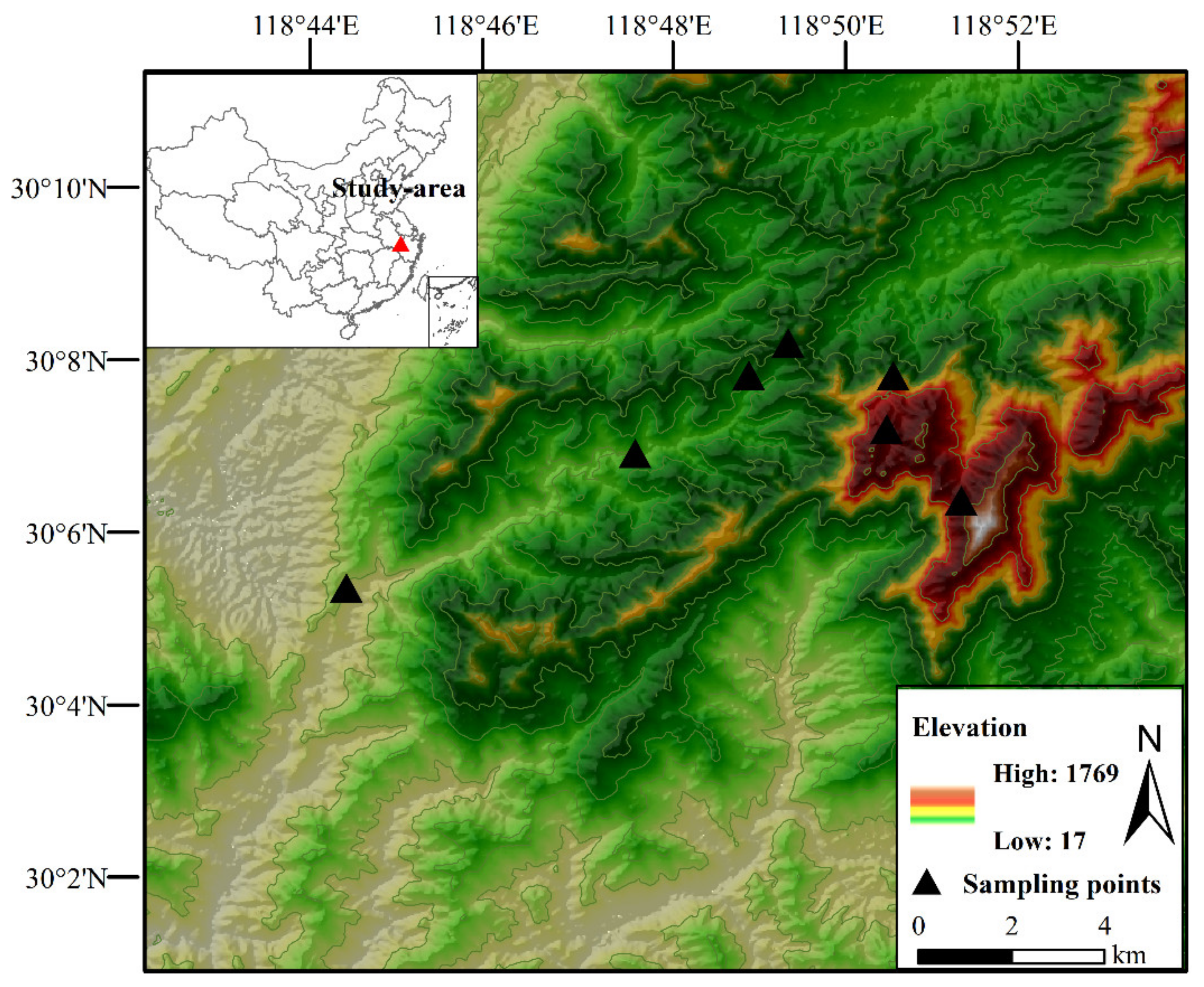
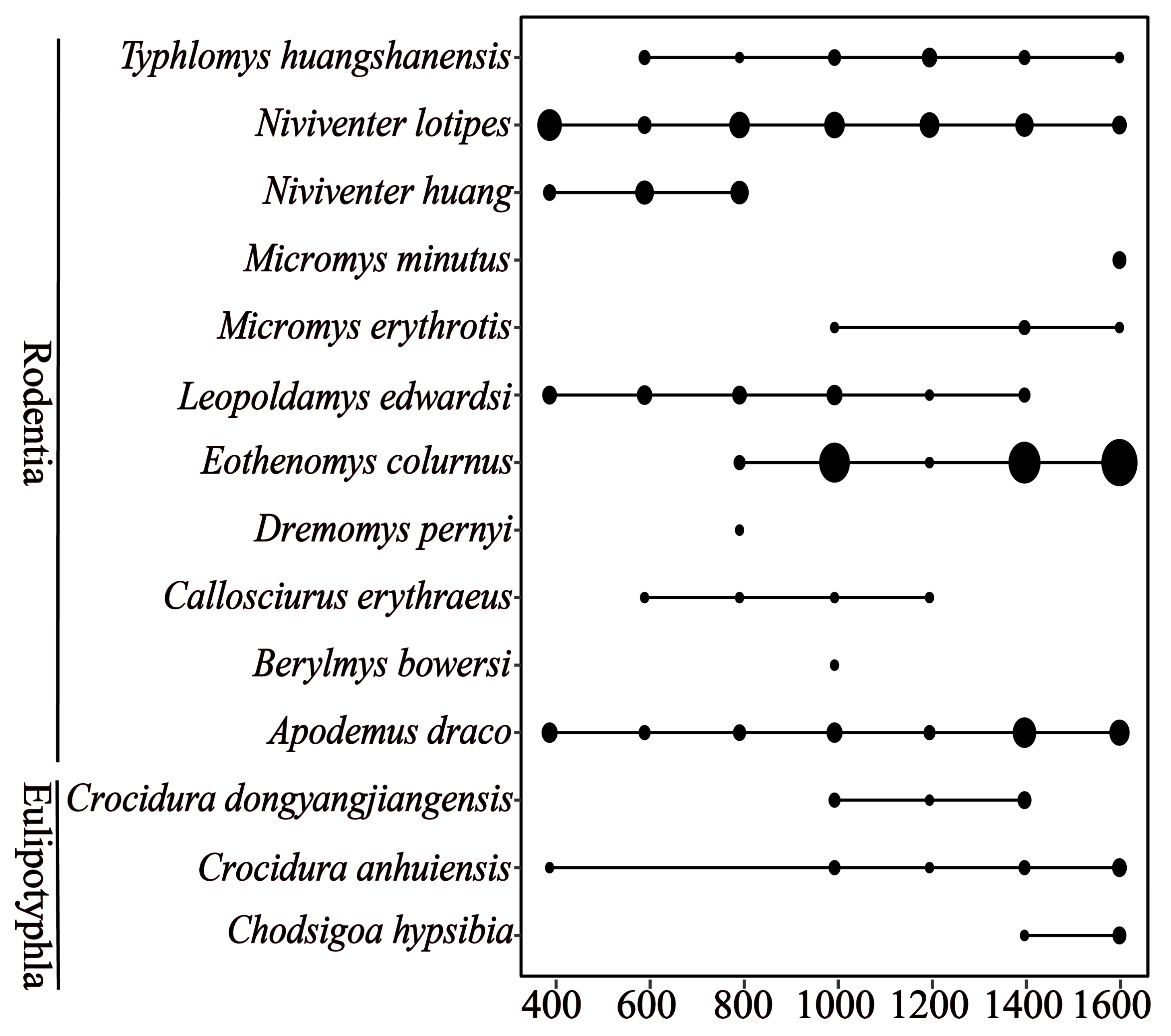
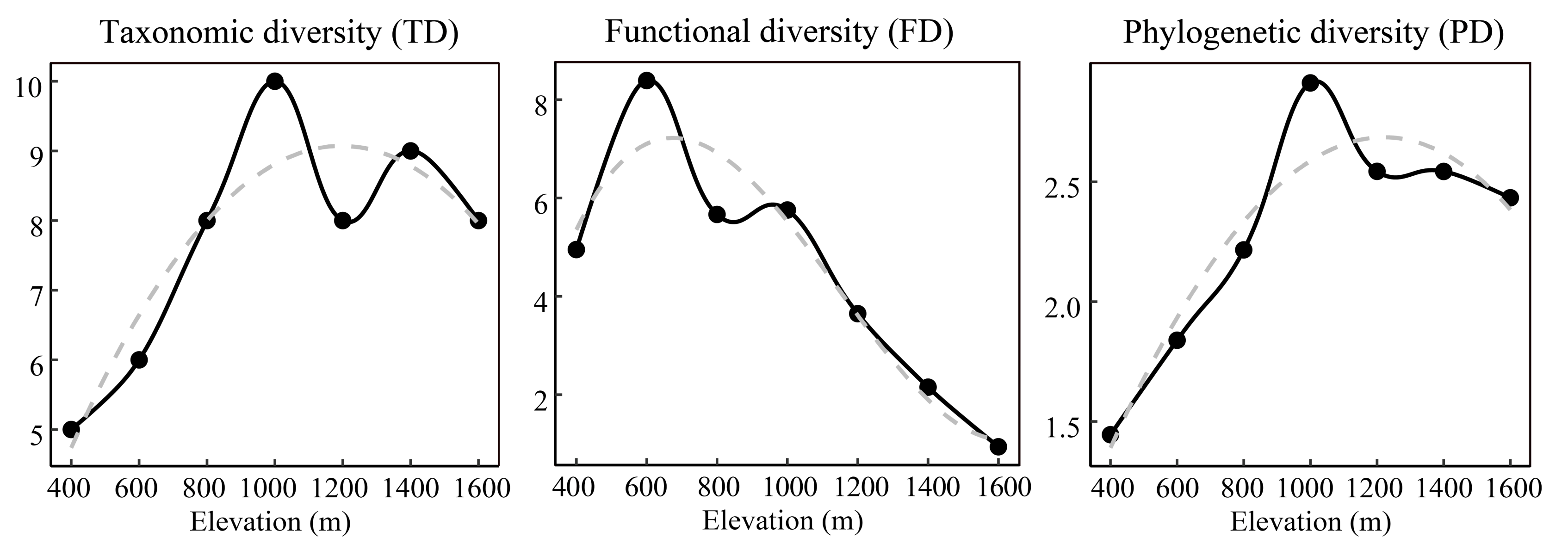
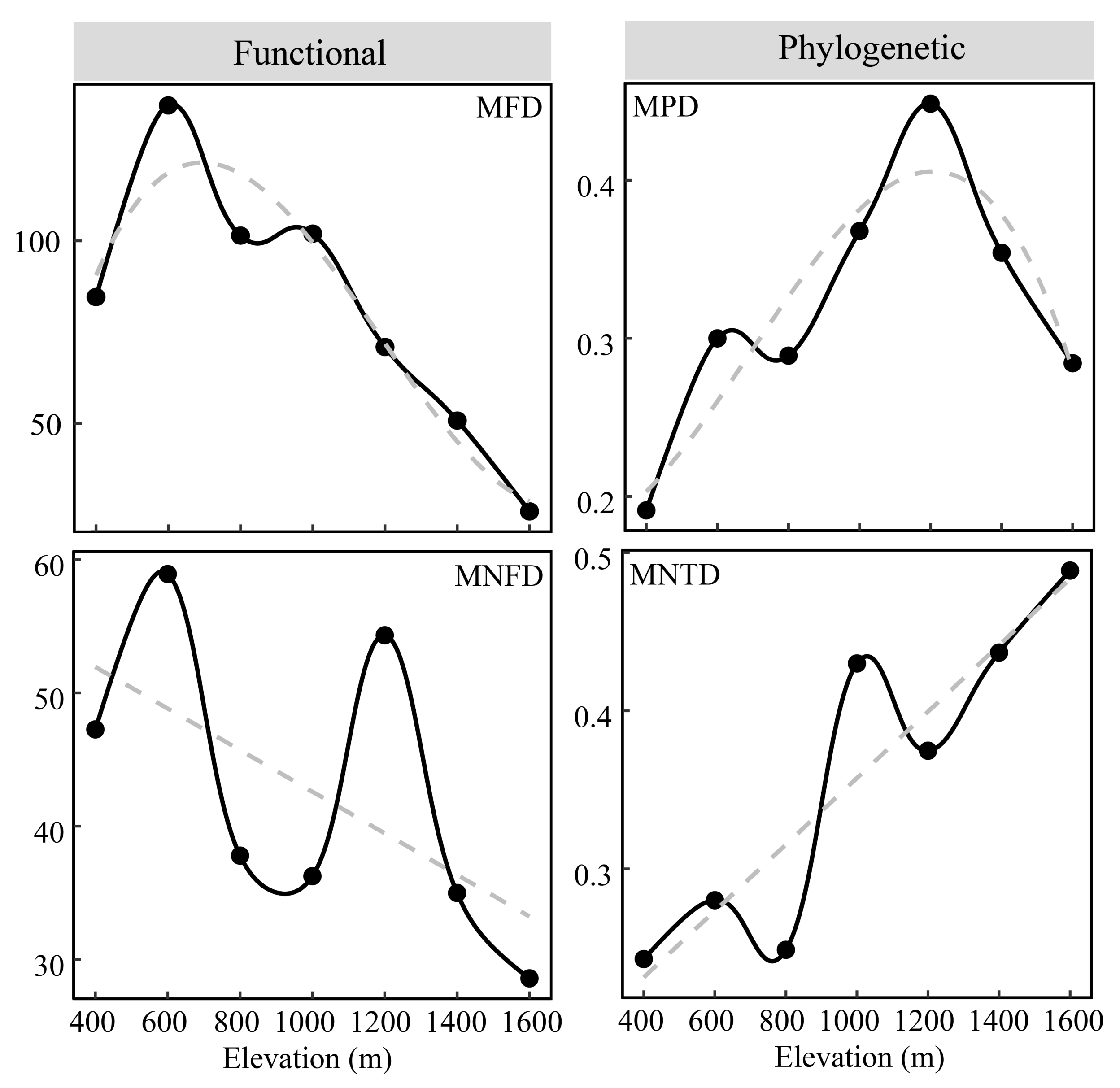
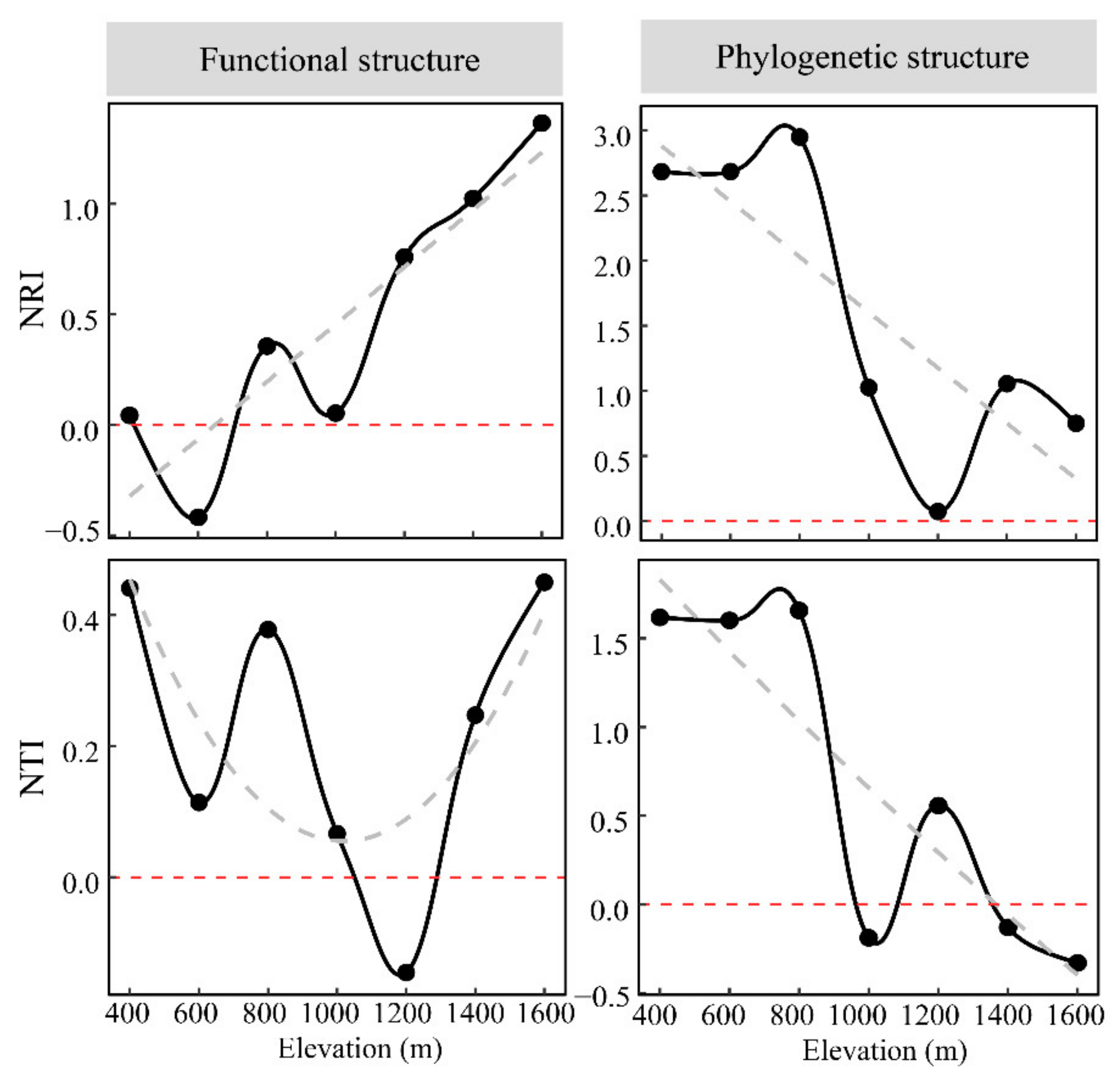
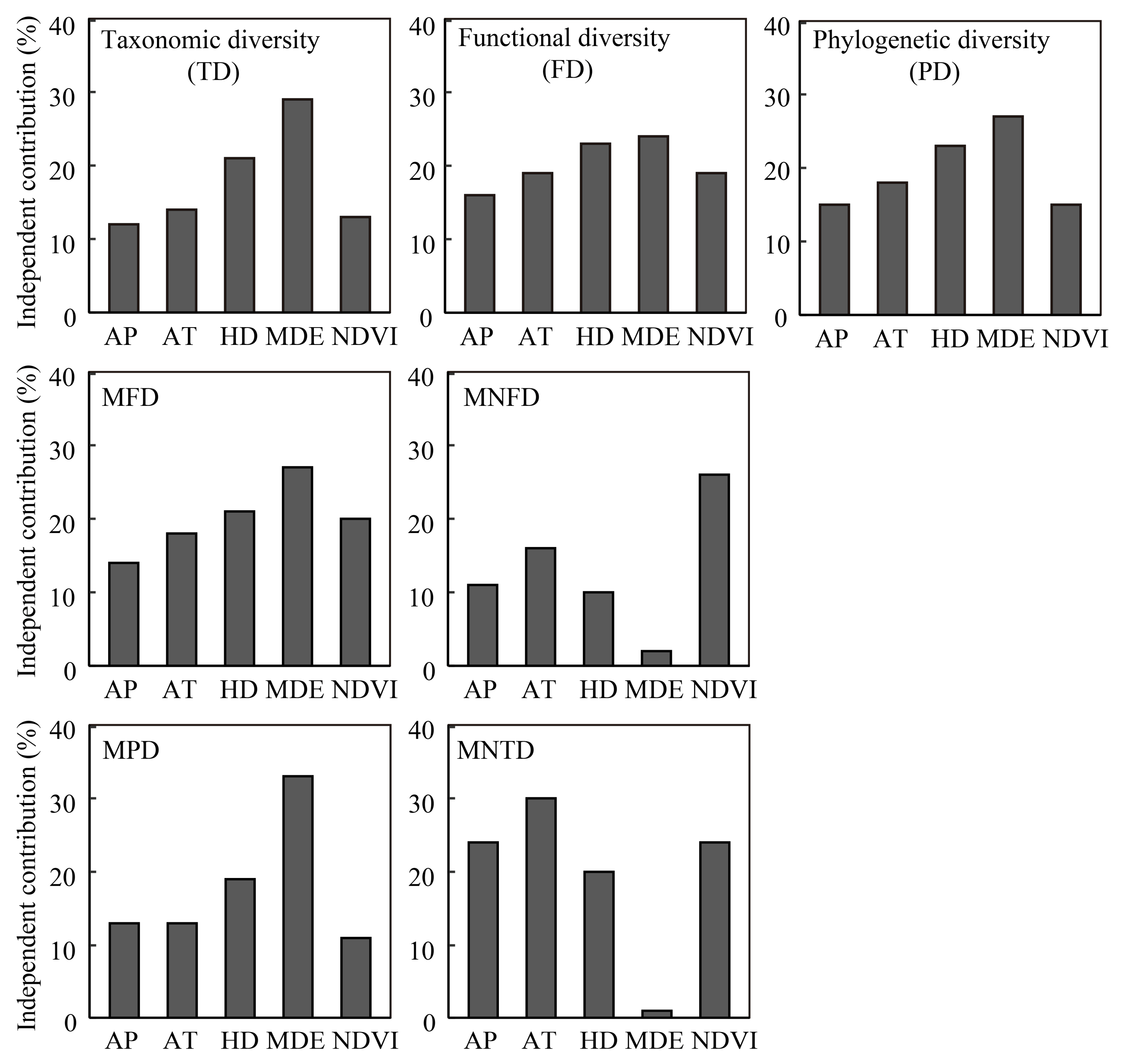
| Index | SR | FD | PD | MPD | MFD | MNTD | MNFD |
|---|---|---|---|---|---|---|---|
| SR | 1 *** | ||||||
| FD | −0.341 | 1 *** | |||||
| PD | 0.973 *** | −0.372 | 1 *** | ||||
| MPD | 0.672 | −0.154 | 0.778 * | 1 *** | |||
| MFD | −0.293 | 0.996 *** | −0.321 | −0.089 | 1 *** | ||
| MNTD | 0.707 | −0.73 | 0.771 * | 0.482 | −0.694 | 1 *** | |
| MNFD | −0.588 | 0.635 | −0.482 | 0.123 | 0.648 | −0.595 | 1 *** |
| Multidimensional Metrics | Standard Coefficient of the Best Model | ||||||
|---|---|---|---|---|---|---|---|
| MDE | HD | NDVI | AT | AP | R2adj | AICc | |
| Species richness (SR) | −0.796 | 0.561 | 25.754 | ||||
| Functional diversity (FD) | 0.600 | 0.914 | 0.948 | 23.280 | |||
| Phylogenetic diversity (PD) | −0.846 | 0.659 | 23.982 | ||||
| MFD | 0.644 | 0.886 | 0.941 | 24.112 | |||
| MPD | 0.726 | 0.432 | 27.545 | ||||
| MNFD | −0.727 | 0.434 | 27.531 | ||||
| MNTD | −0.904 | 0.780 | 20.926 | ||||
Publisher’s Note: MDPI stays neutral with regard to jurisdictional claims in published maps and institutional affiliations. |
© 2022 by the authors. Licensee MDPI, Basel, Switzerland. This article is an open access article distributed under the terms and conditions of the Creative Commons Attribution (CC BY) license (https://creativecommons.org/licenses/by/4.0/).
Share and Cite
Pei, X.; Ren, X.; Hu, J.; Onditi, K.O.; Xu, Y.; Zhang, M.; Chang, W.; Chen, Z. Human Disturbance and Geometric Constraints Drive Small Mammal Diversity and Community Structure along an Elevational Gradient in Eastern China. Animals 2022, 12, 1915. https://doi.org/10.3390/ani12151915
Pei X, Ren X, Hu J, Onditi KO, Xu Y, Zhang M, Chang W, Chen Z. Human Disturbance and Geometric Constraints Drive Small Mammal Diversity and Community Structure along an Elevational Gradient in Eastern China. Animals. 2022; 12(15):1915. https://doi.org/10.3390/ani12151915
Chicago/Turabian StylePei, Xiaoxin, Xueyang Ren, Jiangxiao Hu, Kenneth Otieno Onditi, Yifan Xu, Min Zhang, Wenqing Chang, and Zhongzheng Chen. 2022. "Human Disturbance and Geometric Constraints Drive Small Mammal Diversity and Community Structure along an Elevational Gradient in Eastern China" Animals 12, no. 15: 1915. https://doi.org/10.3390/ani12151915
APA StylePei, X., Ren, X., Hu, J., Onditi, K. O., Xu, Y., Zhang, M., Chang, W., & Chen, Z. (2022). Human Disturbance and Geometric Constraints Drive Small Mammal Diversity and Community Structure along an Elevational Gradient in Eastern China. Animals, 12(15), 1915. https://doi.org/10.3390/ani12151915






